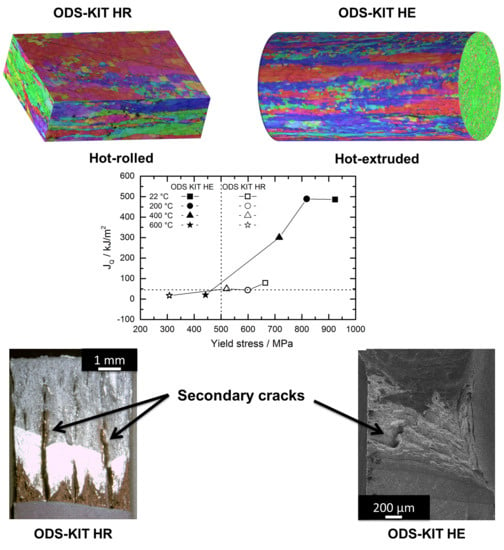Why Do Secondary Cracks Preferentially Form in Hot-Rolled ODS Steels in Comparison with Hot-Extruded ODS Steels?
Abstract
:1. Introduction
2. Materials and Methods
2.1. Material
2.2. Fracture Mechanics Specimens
2.3. Quasi-Static Fracture Toughness Testing
2.4. Microscopy
2.4.1. Basic Characterization
2.4.2 Fracture Surface and Crack Propagation
3. Results
3.1. Basic Characterization of The Microstructure
3.2. Fracture Toughness Tests
3.3. Primary Fracture Surfaces
3.4. Secondary Fracture Surfaces
3.5. EBSD Misorientation Analysis
4. Discussion
4.1. General Factors Affecting Secondary Cracking
- Particle anisotropy: Particles are arranged in the direction of the rolling/extrusion and hence facilitate crack propagation by cleavage or by void growth and coalescence depending on the test temperature.
- Crystallographic anisotropy: Due to the <110> texture induced in the direction of the rolling/extrusion, the shear modulus with respect to the longitudinal direction is different from the isotropic transverse direction.
- Grain morphology anisotropy: Coarse grains are elongated in the direction of the rolling/extrusion which results in crack blunting when the propagating crack is obstructed by the perpendicularly elongated coarse grains.
4.2. Understanding of Secondary Cracking in Hot-Rolled ODS Steels
4.2.1. Effect of Crystallographic Texture
4.2.2. Effect of Grain Morphology
4.2.3. Fracture Mechanisms
4.3. Understanding of Secondary Cracking in Hot-Extruded ODS Steels
4.4. Comparison
5. Conclusions
- At temperatures below the DBTT, the occurrence of secondary cracks in hot-rolled materials is assisted by the {100} cleavage planes which are aligned parallel to the rolling plane. In hot-extruded materials, these {100} cleavage planes are distributed uniformly around the extrusion axis, therefore not assisting secondary cracking.
- At temperatures higher than the DBTT, secondary cracking is more frequent in hot-rolled than in hot-extruded materials as the critical fracture stresses in secondary crack planes are lower due to the two dimensionally anisotropic elongated ‘pan-cake’ shaped grains which allows free crack propagation in two directions. In hot-extruded materials, the one dimensional ‘cigar’ like grain morphology with grains elongated in the direction of extrusion only allows free crack propagation in one direction and hence does not assist secondary cracking as much.
- Sub-micron particle arrangement in two directions assists secondary cracking more in hot-rolled material than one dimensional sub-micron particle arrangement in hot-extruded material.
- The constraint induced stress in hot-rolled materials is higher than in hot-extruded materials which also assists a higher degree of secondary cracking.
- In ODS-KIT HR at RT, secondary cracking arise predominantly through transgranular cleavage and intergranular fracture possibly due to segregations at the grain boundaries. Between RT and 600 °C, secondary cracking occurs through transgranular ductile fracture and at or above 600 °C, secondary cracking occurs through intergranular fracture due to the weakening of the grain boundaries.
Supplementary Materials
Supplementary File 1Author Contributions
Acknowledgments
Conflicts of Interest
References
- Odette, G.R. Recent progress in developing and qualifying nanostructured ferritic alloys for advanced fission and fusion applications. JOM 2014, 66, 2427–2441. [Google Scholar] [CrossRef]
- Byun, T.S.; Yoon, J.H.; Wee, S.H.; Hoelzer, D.T.; Maloy, S.A. Fracture behavior of 9Cr nanostructured ferritic alloy with improved fracture toughness. J. Nucl. Mater. 2014, 449, 39–48. [Google Scholar] [CrossRef]
- Oksiuta, Z.; Hosemann, P.; Vogel, S.C.; Baluc, N. Microstructure examination of Fe-14Cr ODS ferritic steels produced through different processing routes. J. Nucl. Mater. 2014, 451, 320–327. [Google Scholar] [CrossRef]
- Chao, J.; Capdevila, C.; Serrano, M.; Garcia-Junceda, A.; Jimenez, J.A.; Pimentel, G.; Urones-Garrote, E. Notch impact behavior of oxide-dispersion-strengthened (ODS) Fe20Cr5Al alloy. Metall. Mater. Trans. A 2013, 44, 4581–4594. [Google Scholar] [CrossRef]
- Serrano, M.; García-Junceda, A.; Hernández, R.; Mayoral, M.H. On anisotropy of ferritic ODS alloys. Mater. Sci. Technol. 2014, 30, 1664–1668. [Google Scholar] [CrossRef]
- Bramfitt, B.L.; Marder, A.R. A study of the delamination behavior of a very low-carbon steel. Metall. Trans. A 1977, 8, 1263–1273. [Google Scholar] [CrossRef]
- Bourell, D.L. Cleavage delamination in impact tested warm-rolled steel. Metall. Trans. A 1983, 14, 2487–2496. [Google Scholar] [CrossRef]
- Rao, K.V.; Ritchie, R.O. Mechanisms influencing the cryogenic fracture-toughness behavior of aluminum-lithium alloys. Acta Metall. Mater. 1990, 38, 2309–2326. [Google Scholar] [CrossRef]
- Hadraba, H.; Fournier, B.; Stratil, L.; Malaplate, J.; Rouffié, A.-L.; Wident, P.; Ziolek, L.; Béchade, J.-L. Influence of microstructure on impact properties of 9–18%Cr ODS steels for fusion/fission applications. J. Nucl. Mater. 2011, 411, 112–118. [Google Scholar] [CrossRef]
- Serrano, M.; Hernández-Mayoral, M.; García-Junceda, A. Microstructural anisotropy effect on the mechanical properties of a 14Cr ODS steel. J. Nucl. Mater. 2012, 428, 103–109. [Google Scholar] [CrossRef]
- Sridharan, S. Delamination Behaviour of Composites; Woodhead Publishing: Washington, DC, USA, 2008. [Google Scholar]
- Wisnom, M.R. The role of delamination in failure of fibre-reinforced composites. Philos. Trans. R. Soc. A 2012, 370, 1850–1870. [Google Scholar] [CrossRef] [PubMed] [Green Version]
- Kimura, Y.; Inoue, T.; Yin, F.; Tsuzaki, K. Delamination toughening of ultrafine grain structure steels processed through tempforming at elevated temperatures. ISIJ Int. 2010, 50, 152–161. [Google Scholar] [CrossRef]
- Alam, M.E.; Pal, S.; Maloy, S.A.; Odette, G.R. On delamination toughening of a 14YWT nanostructured ferritic alloy. Acta Mater. 2017, 136, 61–73. [Google Scholar] [CrossRef]
- Byun, T.S.; Kim, J.H.; Yoon, J.H.; Hoelzer, D.T. High temperature fracture characteristics of a nanostructured ferritic alloy (NFA). J. Nucl. Mater. 2010, 407, 78–82. [Google Scholar] [CrossRef]
- Kalyanam, S.; Beaudoin, A.J.; Dodds, R.H., Jr.; Barlat, F. Delamination cracking in advanced aluminum-lithium alloys-Experimental and computational studies. Eng. Fract. Mech. 2009, 76, 2174–2191. [Google Scholar] [CrossRef]
- Das, A.; Viehrig, H.W.; Bergner, F.; Heintze, C.; Altstadt, E.; Hoffmann, J. Effect of microstructural anisotropy on fracture toughness of hot rolled 13Cr ODS steel—The role of primary and secondary cracking. J. Nucl. Mater. 2017, 491, 83–93. [Google Scholar] [CrossRef]
- Das, A.; Viehrig, H.W.; Altstadt, E.; Heintze, C.; Hoffmann, J. On the influence of microstructure on the fracture behaviour of hot extruded ferritic ODS steels. J. Nucl. Mater. 2017, 497, 60–75. [Google Scholar] [CrossRef]
- Kim, J.H.; Byun, T.S.; Hoelzer, D.T. Tensile fracture characteristics of nanostructured ferritic alloy 14YWT. J. Nucl. Mater. 2010, 407, 143–150. [Google Scholar] [CrossRef]
- Chauhan, A.; Litvinov, D.; Aktaa, J. High temperature tensile properties and fracture characteristics of bimodal 12Cr-ODS steel. J. Nucl. Mater. 2016, 468, 1–8. [Google Scholar] [CrossRef]
- Rouffié, A.L.; Wident, P.; Ziolek, L.; Delabrouille, F.; Tanguy, B.; Crépin, J.; Pineau, A.; Garat, V.; Fournier, B. Influences of process parameters and microstructure on the fracture mechanisms of ODS steels. J. Nucl. Mater. 2013, 433, 108–115. [Google Scholar] [CrossRef]
- Kasada, R.; Lee, S.G.; Isselin, J.; Lee, J.H.; Omura, T.; Kimura, A.; Okuda, T.; Inoue, M.; Ukai, S.; Ohnuki, S.; et al. Anisotropy in tensile and ductile–brittle transition behavior of ODS ferritic steels. J. Nucl. Mater. 2011, 417, 180–184. [Google Scholar] [CrossRef]
- Kim, J.H.; Byun, T.S.; Hoelzer, D.T.; Kim, S.-W.; Lee, B.H. Temperature dependence of strengthening mechanisms in the nanostructured ferritic alloy 14YWT: Part I—Mechanical and microstructural observations. Mater. Sci. Eng. A 2013, 559, 101–110. [Google Scholar] [CrossRef]
- Alinger, M.J.; Odette, G.R.; Lucas, G.E. Tensile and fracture toughness properties of MA957: Implications to the development of nanocomposited ferritic alloys. J. Nucl. Mater. 2002, 307, 484–489. [Google Scholar] [CrossRef]
- Hoffmann, J.; Rieth, M.; Commin, L.; Antusch, S. Microstructural anisotropy of ferritic ODS alloys after different production routes. Fusion Eng. Des. 2015, 98, 1986–1990. [Google Scholar] [CrossRef]
- Arora, K.S.; Viehrig, H.W. Evaluation of the ASTM and ISO J initiation procedures by applying the unloading compliance technique to reactor pressure vessel steels. J. Test. Eval. 2011, 39, 975–984. [Google Scholar]
- Standard Test Method for Measurement of Fracture Toughness; ASTM Standard E1820-13; ASTM International: West Conshohocken, PA, USA, 2013.
- Wallin, K. Fracture Toughness of Engineering Materials: Estimation and Application; EMAS Publishing: Warrington, UK, 2011. [Google Scholar]
- Wang, C.; Wang, M.; Shi, J.; Hui, W.; Dong, H. Effect of microstructural refinement on the toughness of low carbon martensitic steel. Scr. Mater. 2008, 58, 492–495. [Google Scholar] [CrossRef]
- Das, A. The Influence of Microstructure on the Fracture Behaviour of Ferritic ODS Steels. Ph.D. Thesis, University of Siegen, Dresden, Germany, 2018. [Google Scholar]
- Byun, T.S.; Hoelzer, D.T.; Kim, J.H.; Maloy, S.A. A comparative assessment of the fracture toughness behavior of ferritic-martensitic steels and nanostructured ferritic alloys. J. Nucl. Mater. 2017, 484, 157–167. [Google Scholar] [CrossRef]
- Ashby, M.F. Work hardening of dispersion-hardened crystals. Philos. Mag. 1966, 14, 1157–1178. [Google Scholar] [CrossRef]
- Oliver, E.C.; Daymond, M.R.; Withers, P.J. Interphase and intergranular stress generation in carbon steels. Acta Mater. 2004, 52, 1937–1951. [Google Scholar] [CrossRef]
- Zolotorevsky, N.Y.; Krivonosova, N.Y. Effect of ferrite crystals’ plastic anisotropy on residual stresses in cold-drawn steel wire. Mater. Sci. Eng. A 1996, 205, 239–246. [Google Scholar] [CrossRef]
- Gil Sevillano, J.; González, D.; Martínez-Esnaola, J.M. Heterogeneous deformation and internal stresses developed in BCC wires by axisymmetric elongation. Mater. Sci. Forum 2007, 550, 75–84. [Google Scholar] [CrossRef]
- Gil Sevillano, J.; Alkorta, J.; González, D.; Van Petegem, S.; Stuhr, U.; Van Swygenhoven, H. In situ neutron diffraction study of internal micro-stresses developed by plastic elongation in <100> textured BCC wires. Adv. Eng. Mater. 2008, 10, 951–954. [Google Scholar] [CrossRef]
- Ukai, S.; Izawa, W.; Oono, N.; Hayashi, S.; Kohno, Y.; Ohtsuka, S.; Kaito, T. Charpy impact property related to 100 cleavage fracture in 15CrODS steel. Mater. Sci. Technol. 2014, 30, 1709–1714. [Google Scholar] [CrossRef]
- Yerra, S.K.; Tekog, C.; Scheyvaerts, F.; Delannay, L.; Van Houtte, P.; Pardoen, T. Void growth and coalescence in single crystals. Int. J. Solids Struct. 2010, 47, 1016–1029. [Google Scholar] [CrossRef]
- Altstadt, E.; Serrano, M.; Houska, M.; García-Junceda, A. Effect of anisotropic microstructure of a 12Cr-ODS steel on the fracture behaviour in the small punch test. Mater. Sci. Eng. A 2016, 654, 309–316. [Google Scholar] [CrossRef]
- Pineau, A.; Benzerga, A.A.; Pardoen, T. Failure of metals I: Brittle and ductile fracture. Acta Mater. 2016, 107, 424–483. [Google Scholar] [CrossRef] [Green Version]
- Kim, J.H.; Byun, T.S.; Hoelzer, D.T. High temperature deformation mechanisms of nano-structured ferritic alloys in the context of internal variable theory of inelastic deformation. J. Nucl. Mater. 2013, 442, 458–462. [Google Scholar] [CrossRef]
- García-Junceda, A.; Hernández-Mayoral, M.; Serrano, M. Influence of the microstructure on the tensile and impact properties of a 14Cr ODS steel bar. Mater. Sci. Eng. A 2012, 556, 696–703. [Google Scholar] [CrossRef]
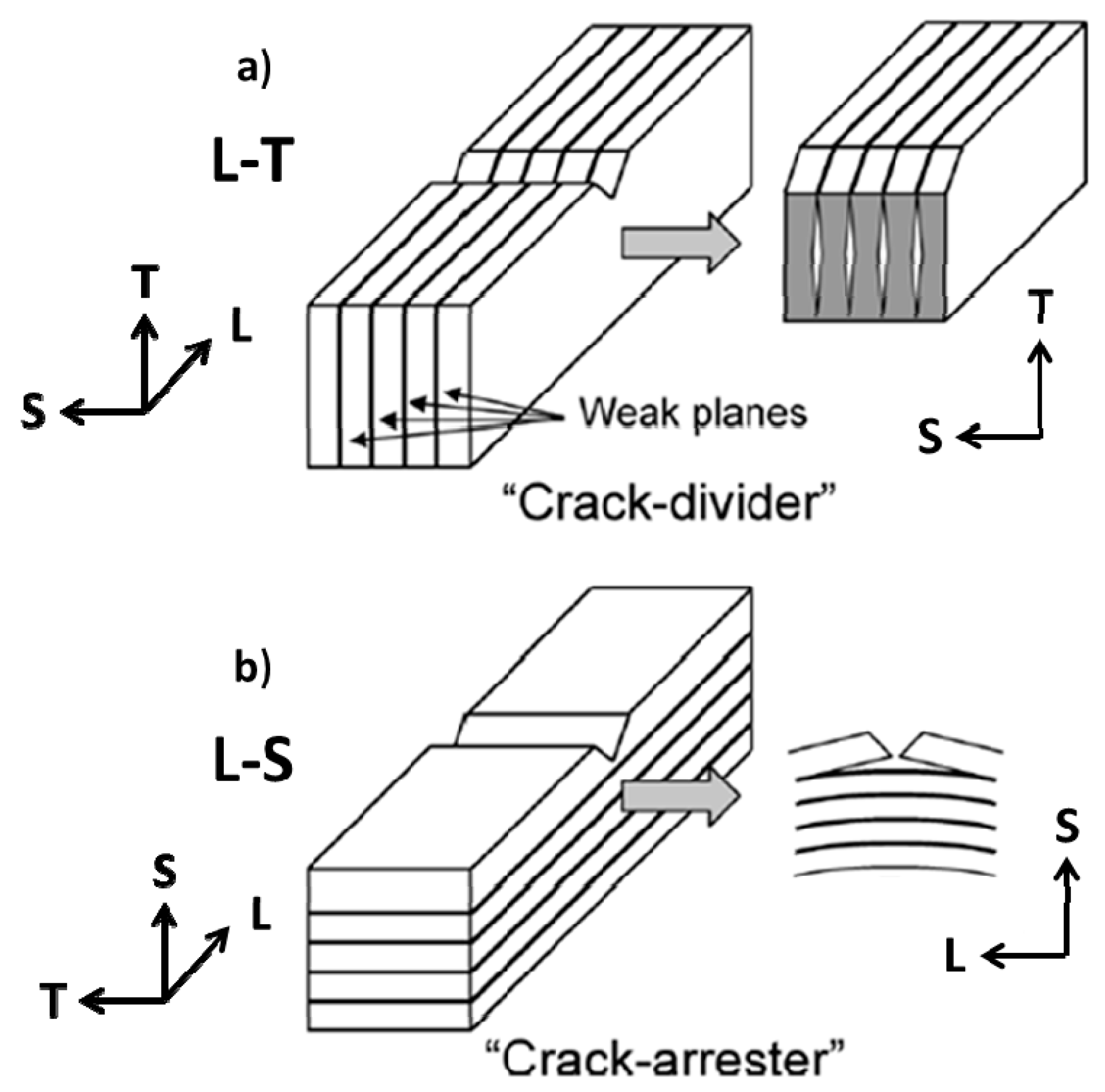
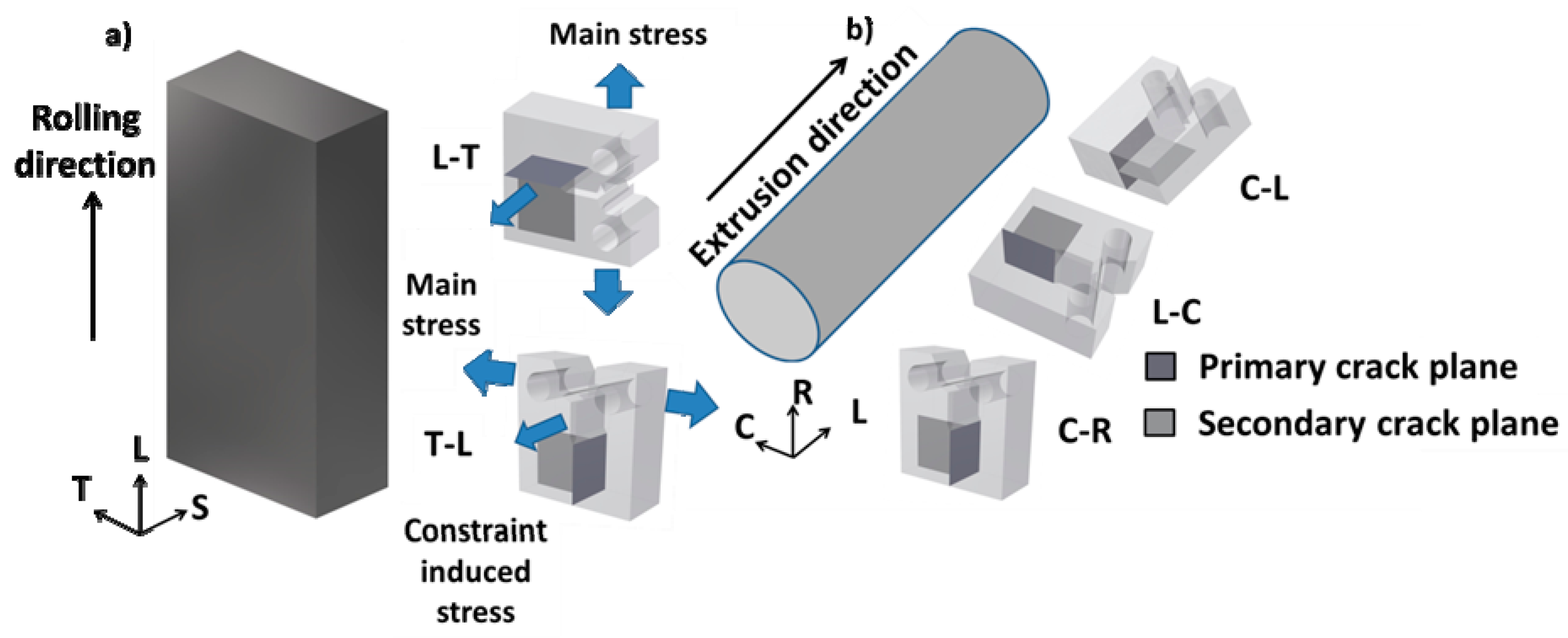
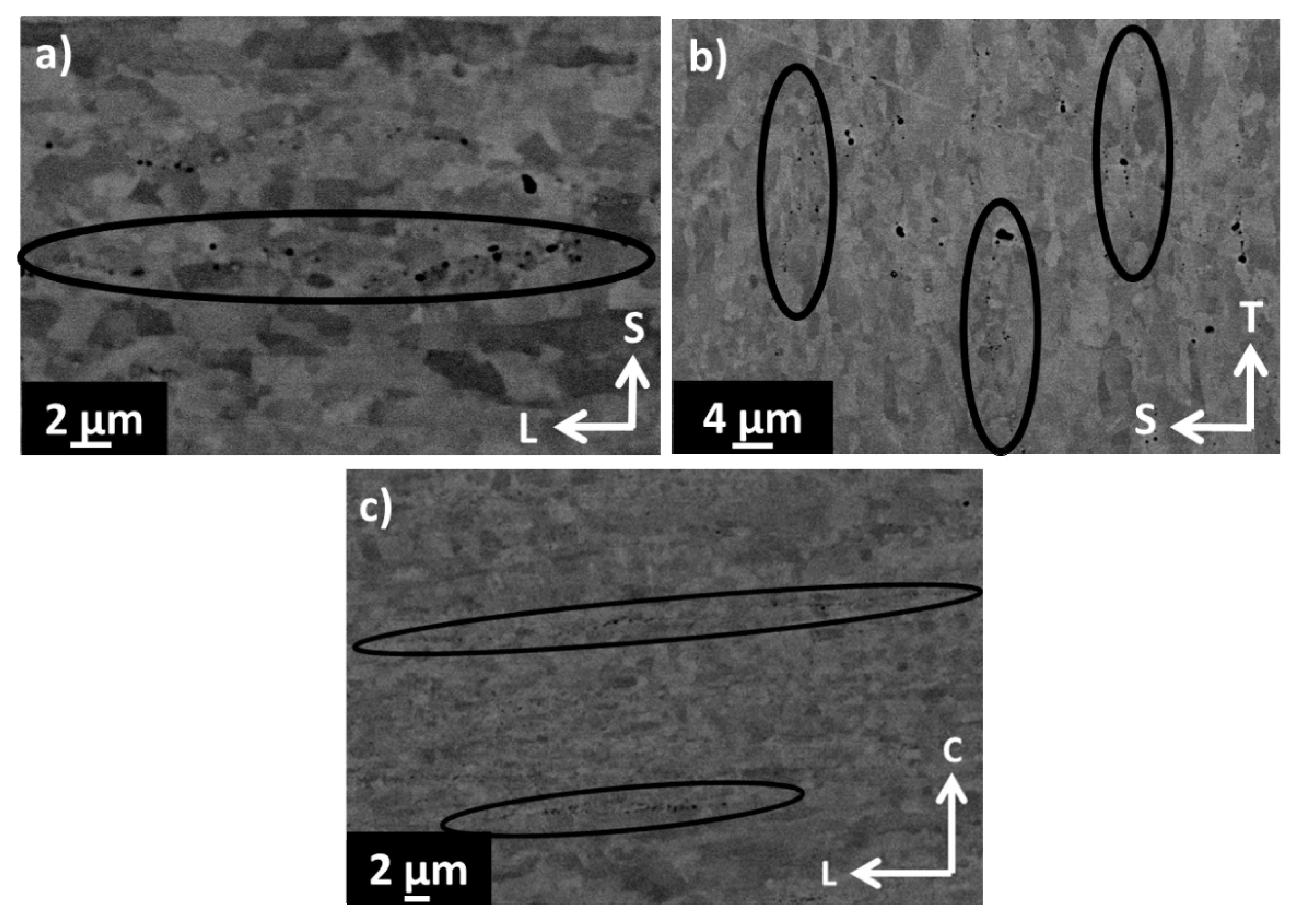
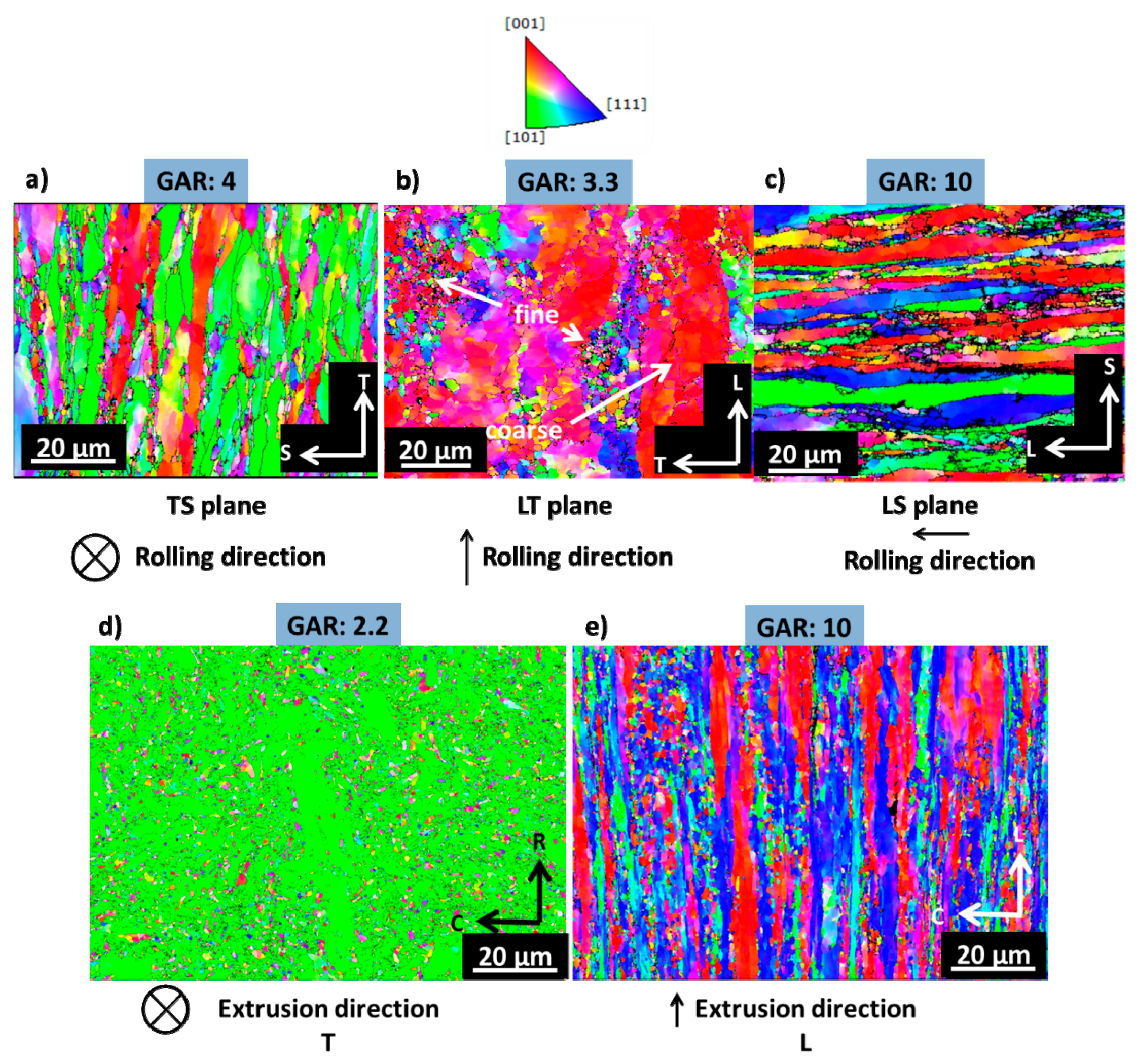
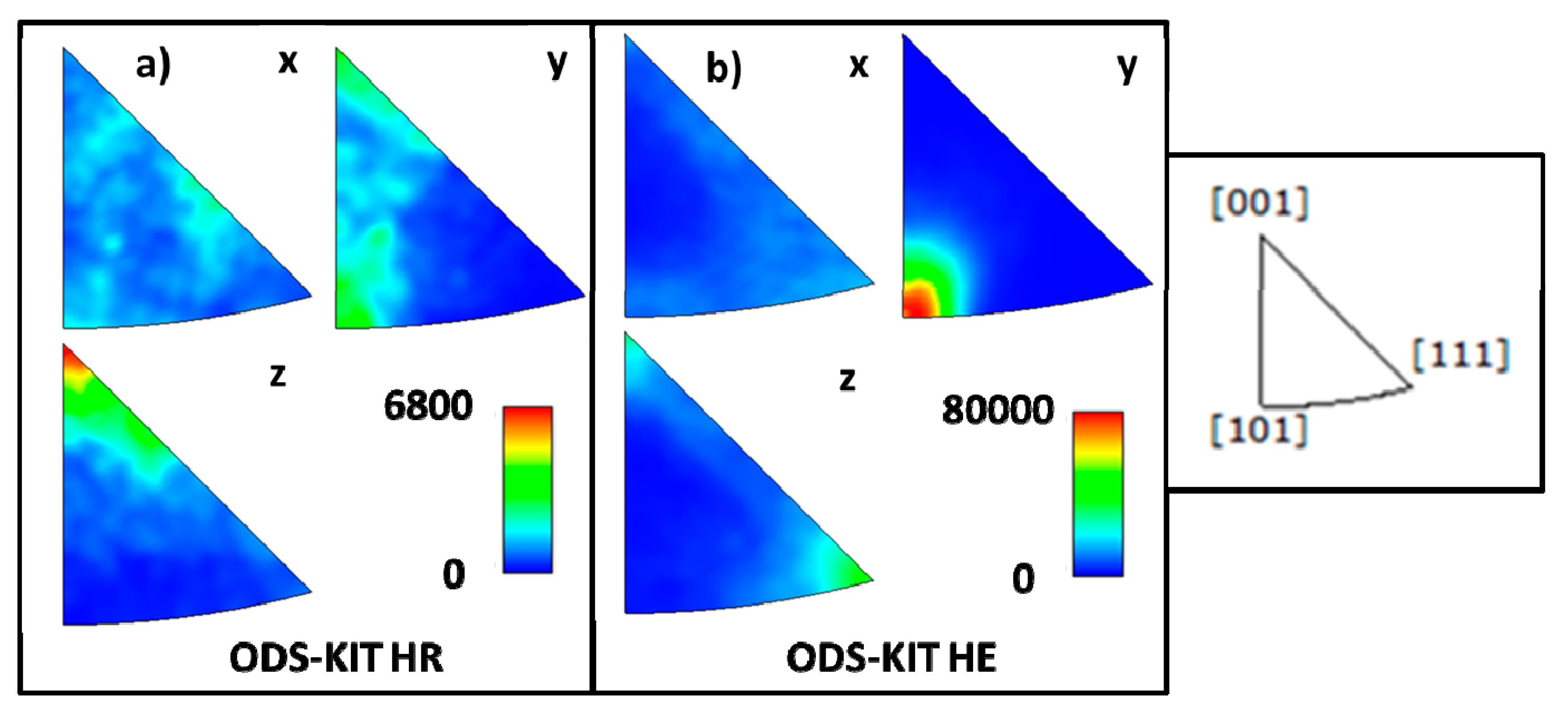



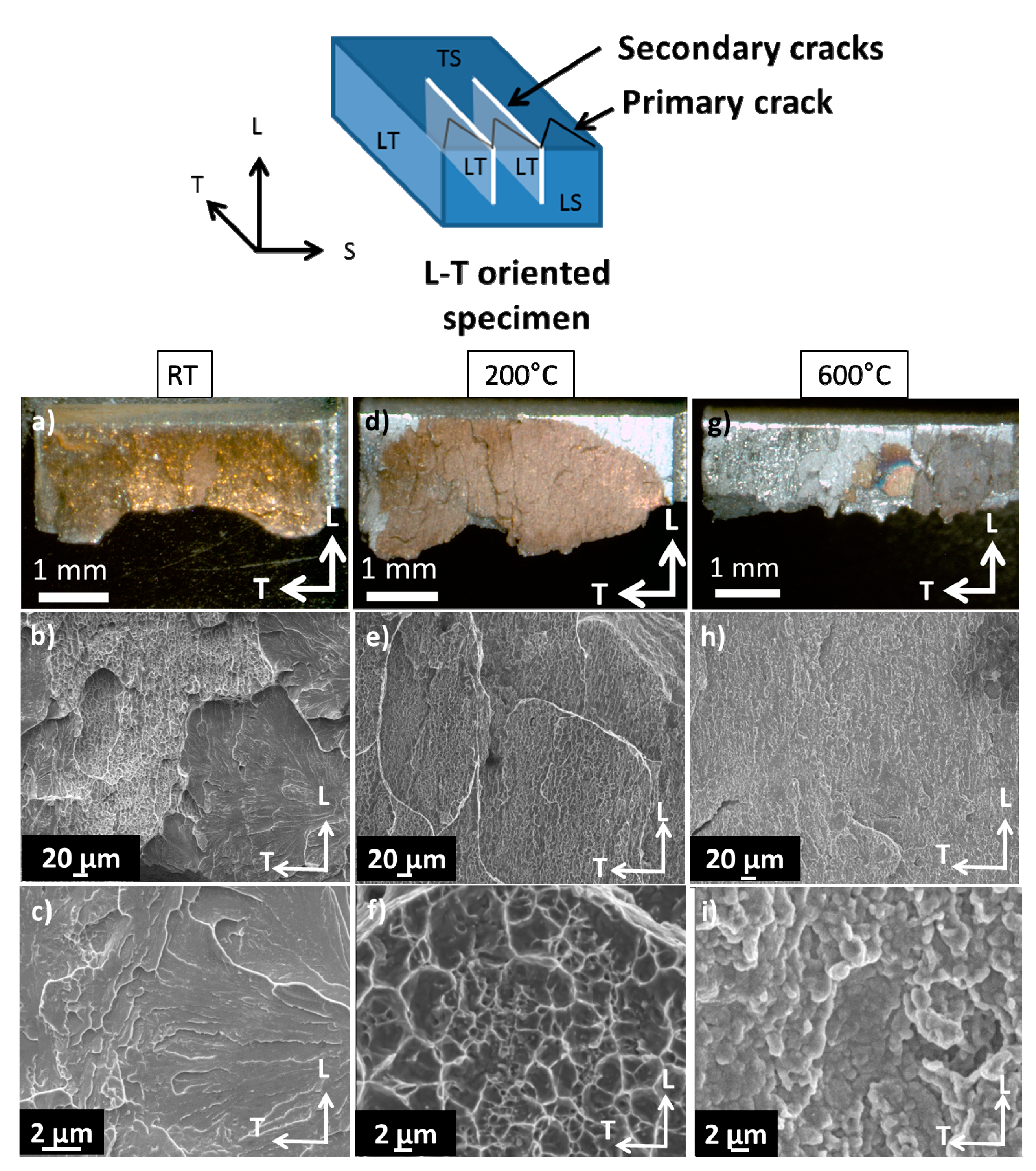


| Material | Plane | Mean Grain Size (µm) | GAR | Area Fraction (%) |
|---|---|---|---|---|
| HR | TS (0.3–3 µm) | 1 | 2 | 20.4 |
| HR | LT (1.4–10 µm) | 3 | 1.6 | 27.3 |
| HR | LS (0.4–3 µm) | 1.1 | 2 | 17.6 |
| HE | T (0.2–3 µm) | 0.78 | 1.7 | 68.9 |
| HE | L (0.2–3 µm) | 0.9 | 1.7 | 39.4 |
| Material | Plane | Mean Grain Size (µm) | GAR | Area Fraction (%) |
|---|---|---|---|---|
| HR | TS (3–13 µm) | 6 | 4 | 79.6 |
| HR | LT (10–91 µm) | 21 | 3.3 | 72.7 |
| HR | LS (3–16 µm) | 6 | 10 | 82.4 |
| HE | T (3–21 µm) | 4.7 | 2.2 | 31.1 |
| HE | L (3–34 µm) | 7.7 | 10 | 60.6 |
| Temperature °C | HE JQ (L-C) kJ/m2 | HE JQ (C-R) kJ/m2 | HE JQ (C-L) kJ/m2 | HR JQ (L-T) kJ/m2 | HR JQ (T-L) kJ/m2 |
|---|---|---|---|---|---|
| −100 | - | - | - | 49.2 | 45 |
| 22 | 486.27 | 97.26U | 44.07U | 78.2 | 28.4 |
| 100 | - | - | - | 45.6 | 15.8 |
| 200 | 488.52 | 146.17 | 107.54 | 43.4 | 19U |
| 400 | 300.73 | 95.6 | 78.06 | 50.1 | 9.9U |
| 600 | 19.69 | 4.04 | 0.95 | 17.1 | 6.5 |
| 700 | - | - | - | 12.9 | 5.8 |
© 2018 by the authors. Licensee MDPI, Basel, Switzerland. This article is an open access article distributed under the terms and conditions of the Creative Commons Attribution (CC BY) license (http://creativecommons.org/licenses/by/4.0/).
Share and Cite
Das, A.; Viehrig, H.-W.; Altstadt, E.; Bergner, F.; Hoffmann, J. Why Do Secondary Cracks Preferentially Form in Hot-Rolled ODS Steels in Comparison with Hot-Extruded ODS Steels? Crystals 2018, 8, 306. https://doi.org/10.3390/cryst8080306
Das A, Viehrig H-W, Altstadt E, Bergner F, Hoffmann J. Why Do Secondary Cracks Preferentially Form in Hot-Rolled ODS Steels in Comparison with Hot-Extruded ODS Steels? Crystals. 2018; 8(8):306. https://doi.org/10.3390/cryst8080306
Chicago/Turabian StyleDas, Aniruddh, Hans-Werner Viehrig, Eberhard Altstadt, Frank Bergner, and Jan Hoffmann. 2018. "Why Do Secondary Cracks Preferentially Form in Hot-Rolled ODS Steels in Comparison with Hot-Extruded ODS Steels?" Crystals 8, no. 8: 306. https://doi.org/10.3390/cryst8080306




